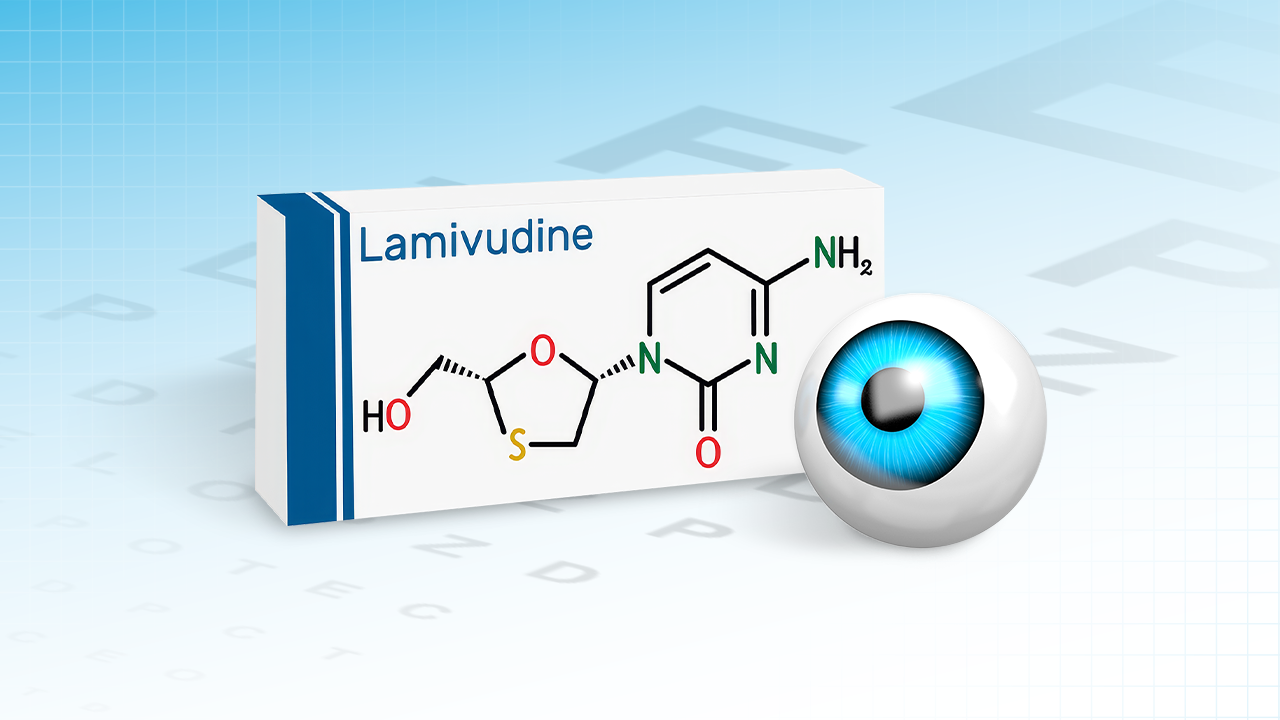Low-cost HIV drug improves visual acuity in diabetic macular edema
A decades-old HIV drug is showing fresh promise for a common diabetes complication that threatens sight. In a small randomized clinical trial, oral lamivudine significantly improved visual acuity in patients with diabetic macular edema (DME), an outcome that could shift the treatment paradigm toward more affordable, injection-free care.¹
READ MORE: Advances in AMD and DME Take Center Stage at APAO 2025
Promising results from a low-lift trial
Researchers from Universidade Federal de São Paulo (Brazil) and UVA Health (USA) enrolled 24 adults with center-involved DME in a double-blind, placebo-controlled trial. The patients were randomized to receive either lamivudine (150 mg twice daily) or placebo for eight weeks. At week four, both groups began intravitreal injections of bevacizumab (1.25 mg).
The co-primary endpoint was improvement in best-corrected visual acuity (BCVA). Key results included:
- At 4 weeks, the lamivudine group improved by 9.8 letters, while the placebo group lost 1.8 letters (p < 0.001).
- At 8 weeks, those receiving lamivudine plus bevacizumab improved by 16.9 letters, compared to 5.3 letters with bevacizumab alone (p < 0.001).
- Lamivudine outperformed ranibizumab (p < 0.05) and was comparable to aflibercept (p = 0.5), based on synthetic control comparisons with Protocol T.
No safety red flags or differences in retinal thickness were observed between groups.
READ MORE: FDA Approves the First Anti-VEGF Port Delivery System for DME
Why a pill matters more than you think
DME affects millions globally and remains a leading cause of vision loss.2 Standard treatment typically involves monthly intravitreal injections of anti-VEGF therapies. It’s a schedule few enjoy, and even fewer can afford.
That’s why researchers are investigating lamivudine, a cheap, shelf-stable oral drug long approved for HIV. In this study, it showed notable visual gains even before patients received any injections, pointing to potential as a standalone therapy or a powerful partner in a combo approach.
“A $20-a-month or even cheaper oral pill that improves vision as much as or more than therapy with injections into the eye that cost up to $2,000 per month could be transformative both for patients and the health care system,” said Dr. Jayakrishna Ambati, senior author and founding director of UVA’s Center for Advanced Vision Science.
Researchers attribute lamivudine’s effect to its ability to block inflammasomes, which are immune system components that normally fight infections but also stir up damaging inflammation in the retina. This gives lamivudine a different biological target than anti-VEGF agents, and that distinction could matter.
READ MORE: Bevacizumab Proves Non-inferior to Ranibizumab in 12-Week Trial
Study design and outcomes at a glance
The study, published in Med (Cell Press), ran from February 2022 to September 2023. It enrolled 24 adults with center-involved DME and BCVA less than 69 letters.
Participants were randomized to receive either oral lamivudine (150 mg twice daily) or placebo for 8 weeks. Both groups received bevacizumab injections starting in week 4.
Findings included:
- A 9.8-letter improvement in the lamivudine group at 4 weeks versus a 1.8-letter decline with placebo (p < 0.001).
- A 16.9-letter gain after 8 weeks with lamivudine plus bevacizumab, compared to a 5.3-letter gain in the bevacizumab-only group (p < 0.001).
- Lamivudine’s results beat out bevacizumab and ranibizumab in synthetic comparisons, and were equivalent to aflibercept.
The trial reported no adverse effects or differences in retinal thickness between groups, which is an encouraging sign for long-term use.
Implications for access and global DME treatment
While intravitreal anti-VEGF injections remain the current gold standard for DME, they are expensive, invasive and logistically difficult, especially in low-resource settings. Patients often require monthly visits to retina specialists, posing major barriers in terms of travel, cost and clinic capacity.
The drug’s unique mechanism, targeting inflammasomes, also opens the door to dual-action therapies. For patients who can’t tolerate injections or stick to frequent appointments, a pill may finally meet them where they are.
While it is early days, these findings suggest that lamivudine could not only supplement existing therapies, but also possibly reshape how we approach retinal disease altogether.
READ MORE: Three New Potential Alternatives to Anti-VEGF
What’s next for lamivudine in DME?
The trial’s sample size was small and the follow-up period short, so the findings should be interpreted with care. Still, the signal is strong enough to justify additional studies. Larger, longer-term trials will be needed to assess the durability of benefit and clarify whether lamivudine works best as a standalone treatment or in combination with anti-VEGF injections.
The research team is already working on K9, a new derivative of lamivudine, designed to retain its inflammasome-blocking potential while minimizing possible side effects. Trials for K9 are underway, and investigators hope it could one day offer a safer, even more effective oral option for DME patients.
In a field that has long relied on needles and high-cost biologics, an inexpensive and accessible oral therapy that delivers clinically meaningful visual gains could shift the treatment paradigm. For now, lamivudine offers an intriguing proof of concept that an existing drug might help restore sight to millions of people living with DME.
Editor’s Note:
- For more information, see the original press release from UVA Health. This information is intended for eye care professionals only. The product(s) mentioned may not be approved for use in all territories.
- This content is intended exclusively for healthcare professionals. It is not intended for the general public. Products or therapies discussed may not be registered or approved in all jurisdictions, including Singapore.
References
- Pereira F, Magagnoli J, Ambati M, et al. Oral lamivudine in diabetic macular edema: a randomized, double-blind, placebo-controlled clinical trial. Med (N Y). 2025;6(6):100747.
- Lee R, Wong TY, Sabanayagam C. Epidemiology of diabetic retinopathy, diabetic macular edema and related vision loss. Eye Vis (Lond). 2015;2:17.



